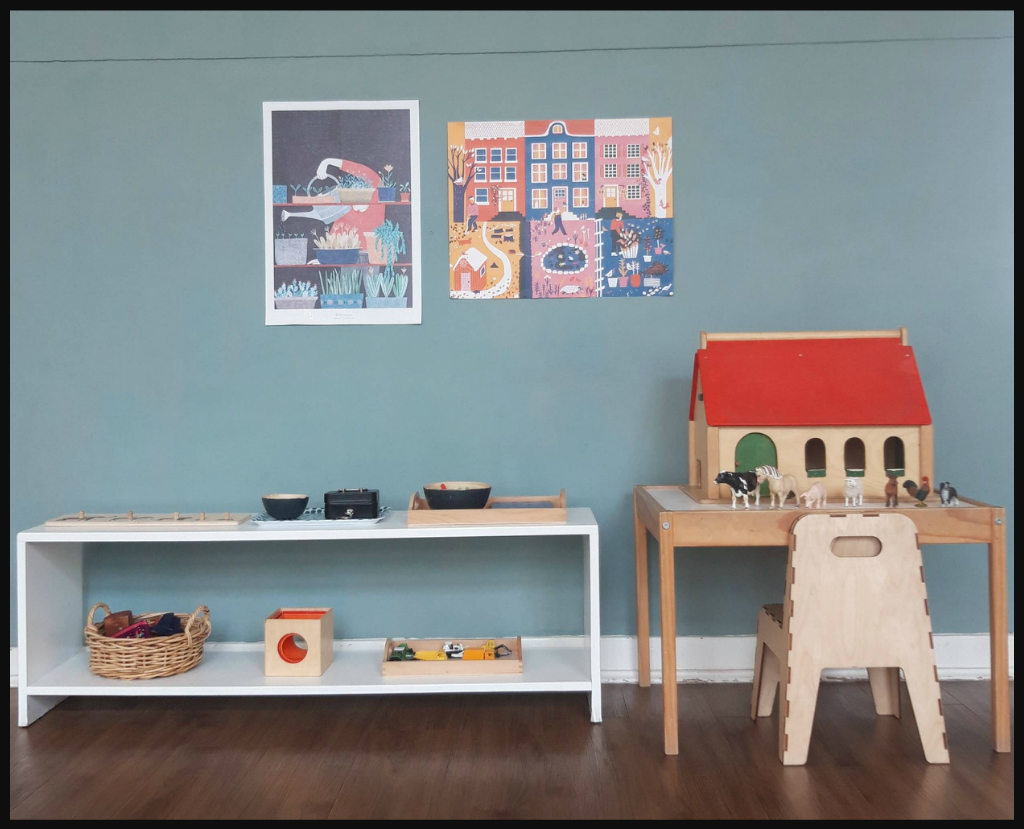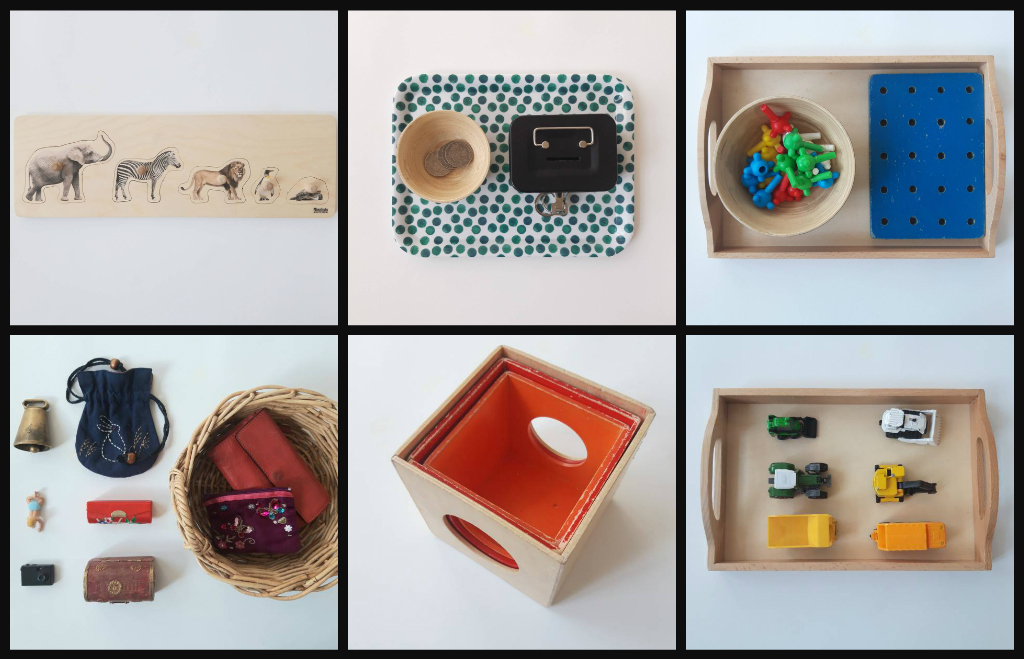Montessori activities for 15 to 18 months
It’s fun to be back with this series about Montessori activities for different ages. Today we’ll look particularly at Montessori activities for 15 to 18 months.
What skills are they practising at this age?
When I am selecting activities for a child, I like to always ask “what skills are they practising at this age?”
15 to 18 month olds are often working on:
- refining their grasp and eye-hand coordination
- moving their body – many starting to get steadier on their feet, to running, climbing, pushing a tricycle with their feet, swinging, hanging from their arms, and carrying heavy objects (maximum effort); plus dancing and making music (with instruments)
- language – continues to explode around this age. Keep naming everything around you, use rich language, read books, and play games with vocabulary baskets
- some one step practical life activities can begin to be offered – eg, drinking from a glass, pouring a glass of water using a small jug/pitcher
- self expression – we can begin to offer some simple but beautiful art materials for them to explore
- social development – continuing to observe other children, try interactions with other children, siblings may be able to play together, and increasing interest in collaboration on activities around the home with us
Some common questions about activities
Do we need every activity in our home?
Absolutely not. Please always observe your child, what they are mastering right now, and as much as possible use what you already have.
Use the ages give as a guideline only. Some children will be working a lot with activities on their shelf, some moving ahead with language, others busy with gross motor development and real-life activities around the home (like helping with cleaning, washing, cooking), and some showing some interest in arts and crafts.
So adjust the activities available based on their interests. And I like to keep observing so I know when to change out an activity – often if an activity is being ignored or being “dumped”, it is not providing the right challenge to our child and can be rotated for something else.
What if they don’t want to do any shelf activities?
That is totally fine! The young toddler is an explorer. They are touching and feeling and exploring the world around them.
First I always ask parents, what do they like doing? Maybe right now all they are interested in is being outside, or something to do with water, or talking all the time. Then that is what they are telling you they want to be practising right now. And provide more opportunities for these activities.
What if they don’t complete the activity?
They may not complete the activity. What part of the activity interests them? We don’t need to push them to finish the whole thing. It’s a process. Some children do this slowly, day by day. Others seem only to remove all the pieces and then a month later, they can magically do the whole activity. Follow the child. Help as little as possible and as much as necessary.
Ask if they need help if they get stuck. Give them a verbal cue like, “Turn, turn.” Ask them if they’d like to us to show them. Or simply provide emotional support if they refuse all help and are just frustrated it won’t work out.
What if they stand at the shelf to work and don’t bring it to the table?
With a young toddler from 15-18 months, I find they often work standing or sitting by the shelf. If we interrupt them to move the activity to a low table or mat, they often get distracted and move onto the next thing.
So I prefer to preserve concentration and if they are already focussed on something on the shelf, I leave them there.
Sometimes there is a very small moment before they get started, where we can invite them to take it to their table. “Look, this is how we carry the tray to the table.” They will copy how we carry it and their wrist strength is generally not yet developed so much, so we use two hands to carry the tray or basket.
It is nice for them to eventually learn to bring work from a shelf to a table or mat as it helps them to focus on one activity at a time, they learn to take responsibility for putting it back, it adds movement to the activity, and there are more steps which is great for building executive functioning skills.
So with those questions answered, let’s see which are my favourite Montessori activities for 15 to 18 month olds.
How much should I show them and how much should I let them explore?
I like to have activities set out for them to explore independently. I like to present them on a tray or in a basket so it’s clear what the purpose is for. Often the activity is “undone”, for example, with all the parts in a bowl to the left, so it’s calling them to fit it together for themselves.
In this way, they are invited to make discoveries for themselves.
If they get stuck, then I like to step in to ask if they’d like some help. Then step back to see how they get further by themselves.
You may find that they use the activity in a way that we were not even expecting. And that’s ok too.
Or they may use their fingers, rather than a set of tongs we have set out. And will come to the tongs when they are ready.
Shelfie version 1

- 5 to 9 piece knobbed puzzle – they first practice removing the pieces; around 18-months, some of the pieces may be able to be replaced in the hole. Circles are the easiest to replace as there are no corners. I like to look for realistic (rather than cartoon) picturess, for example, of vehicles, animals or tools, as they will recognise these easily from their daily life.
- Coin box – I love the coin box. They love to work out how to drop the coins in the slot and then, once mastered, how to open the box with the key. You can find these in stationery stores.
- Stacking peg toy – I wish I had a link for this peg board which has been used and loved for years in my classroom. It’s called the Kobba peg board and I found it in Australia but can no longer source it. This is the closest I can find here.
- Opening and closing basket – I cannot tell you how much I love this activity. I find it being used by the 15-month olds, right through to the 3 year olds. I look for old purses with different openings (zipper, press stud, pull cord etc) and hide something inside for them to find. Be careful of choking hazards.
- Nesting box – this one was found at a market, similar to the more expensive Grimms Stacking boxes. My tip here is to simplify to 3 to 5 pieces for our younger toddlers. Try the smaller ones, the bigger ones, and see which ones provide the right challenge for them.
- Tray of construction vehicles – be careful with small parts, but this tray is wonderful for using as a vocabulary set. They can learn the names as they push, park and line them up. I’ve collected mine over the years, but you can find similar here.

Shelfie version 2

- Musical instruments to bang – I love this tone drum from Plan Toys. The sound is lovely and the soft beater makes it pleasant for adults too. (Always check the sound of children’s toy instruments – some make some not so pleasant sounds even if made of wood.)
- Threading onto a stick – this is part of a large educational set, but perhaps you can make your own from a dowel and I just found this set from Melissa and Doug (you don’t need to use the matching cards yet – better once they are2.5+ years). I love starting with a straight stick before moving onto a thread which they will need more assistance with. You might start by holding the stick for them. But gradually they will be working with two hands together. Be careful with small parts. Put out a limited number of beads.
- Rings onto coloured dowels – this is often seen in Montessori classrooms as it is practicing threading onto a stick and eventually to matching the colour. I never correct them if they place the ring on the wrong colour. One day you will notice them discover it all by themselves. It’s magical to see their eyes light up. And you know they are now starting to become aware of colours, although it will still be some time before they are able to name the colours.
- Scribbling – I love these chunky Stabilo 3-in-1 pencils which give great colour. You’ll see toddlers using any grasp to hold them and move from their whole shoulder. So sometimes the larger the paper the better at this age. They are using the pencil for self-expression, not to draw something, so we can simply describe the colours rather than asking them what they have drawn.
- Playdough – make some homemade playdough, find an airtight container they can open themselves (this one by Leifheit), and provide some simple cookie cutters, a rolling pin, and possibly an unserrated butter knife. Here’s a link to my playgroup website with my favourite recipe here which I share with families.
- Watercolour painting – this is a simple activity for a young toddler that gives easy results for them. They dip a paintbrush in the water, then on the watercolour tablet, then onto the paper. Et voila. Very satisfying. Again I get the watercolour tablets from an educational supplier but you could pop out one colour at a time to stop them mixing them together to a lovely brown :). Look for a small jam jar to put out just a small amount of water, include an underlay to protect the table, and have a cloth at the ready for spills.

Wanting more activities?
- 3 – 6 months
- 6 – 9 months
- 9 – 12 months
- 12-15 months
- 15 – 18 months
- 18 – 21 months
- 21-24 months
- 2 years – 2 years 3 months
Check back for more activities by age coming soon. You can also download a free 42-page pdf of Montessori activities by age (0 to 4 years) from my website.

Simone Davies has more than 20 years’ experience as an AMI Montessori educator. Simone is the author of “The Montessori Toddler” and co-author of “The Montessori Baby” and “The Montessori Child” books, comprehensive guides to raising children in a Montessori way. She currently runs parent-child Montessori classes in Amsterdam at her school Jacaranda Tree Montessori. She also has a popular blog, instagram and podcast “The Montessori Notebook” and is mother to two young adults.